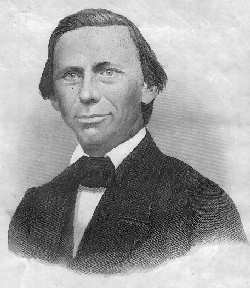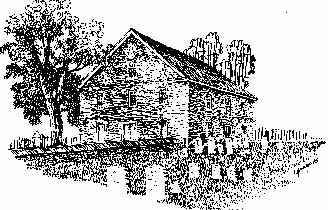Collecting Delaware Books
Books of Our Methodist Peninsula
Substantially revised since 1994 publication
Perhaps no religious denomination has more influenced Delaware's history and contributed as much writing as Methodism. Other churches were here first. Swedish Lutherans, Anglicans, and Friends were established by 1700. The Roman Catholic church appeared in 1730 and the Presbyterian in 1737. The first Methodist preacher landed in Delaware in 1739, and that was almost by chance.
Methodism originated in England in 1729. In 1738, the 24-year-old evangelist George Whitefield began the first of his seven trips to America. His ship was forced to take shelter from a storm at Lewes, Delaware, in 1739. Whitefield preached there, despite angry condemnation by the established Anglican clergy.
Capt. Thomas Webb preached Methodism in Wilmington and Brandywine Hundred in 1769 and Murderkill Hundred in 1778. Bishop Francis Asbury preached in New Castle in 1772 and Freeborn Garrettson in Lewes in 1779. A Kent County circuit was organized in 1774, and Methodist camp meetings were held as early as 1805 west of Wyoming, Delaware. It soon became the favored denomination of the ordinary people — farmers, laborers, and artisans. The Tory Delaware upper classes continued "high church" worship and snubbed the Methodists.
Three Methodist Books
However, it is local Methodist books we are interested in here. There were a number of them. The printed word was an evangelistic tool as well as a useful fund raiser for a denomination that did not have wealthy congregations. Such books often contain priceless pictures of 19th-century life that can not be found in the standard histories.
Thirteen Years' Experience in the Itinerancy by the Reverend Andrew Manship was first published in 1855. It was revised and reprinted many times. The 1876 edition, for example, adds stories of Manship's trip to Europe.

Methodists moved their ministers regularly and still do, so Manship's book tells of assignments in Philadelphia, Lancaster, Wilmington, Easton, Md., Milford, and other locations. His comments on Milford are interesting.
"In the spring of 1845, The Philadelphia Annual Conference was held in Milford, Delaware. When I arrived in Philadelphia, on my way to the Conference, I met with a gentleman, Captain George Primrose, who invited me to take passage with him in his vessel. The invitation was accepted. The winds were favorable, and the trip in every way pleasant… .
"The town looked very inviting. It seemed to me that there had been a general renovation. Almost every house had been either painted or whitewashed. This is one of the largest business places in the state. There is a great amount of sociability in this place and I suppose that the Conference was never more hospitably and liberally entertained. A person might say the treatment received during an Annual Conference, which may come to a given place only once in a lifetime, is not a sufficient test of the general character of people for hospitality. It was my lot to remain in Milford, as a junior preacher and the opinion I formed during the session of the Conference, relative to their generosity, became strengthened with length of acquaintance."
Manship had quite a different feeling for New Castle. "In New Castle the Methodist Church is not the strongest. Our Episcopalian and Presbyterian friends are older both … churches have been established more than a hundred years! Their antiquity gives them strength. Moreover, in the town of New Castle there is a greater amount of aristocracy than in any town in which it has been my lot to labor and our Church is not well suited to the aristocracy of this country as others."
Manship was assigned to the Wesleyan Female Collegiate Institute in Wilmington in 1852. Founded in 1839, it drew women students from many states. However, by the time of Manship's tenure, the school was in financial difficulty and was put up for sheriff's sale.
Manship reports, "I was present at the sale, and, although I am not in the habit of being in bar-rooms, that day I was anxiously looking on, to see into whose hands the Institute would fall. It was generally rumoured that the Roman Catholics would be the purchasers, and convert it into a nunnery, orphan's asylum, or something else."
After describing the auction, he tells how everyone's heart fell when a "fine priestly-looking man" won the bidding. But the buyer soon revealed himself to be Amos Phillips, Esquire, a good Methodist and Philadelphia lawyer who had been retained by the Methodist church to save the property.
Robert W. Todd's Methodism of the Peninsula, copyright 1886, is a similar book, though it deals more directly with people and congregations. There are many stories of "muscular Christianity" and of the hardships suffered by circuit riding preachers. Todd also had a sense of humor that Manship lacked.
One of the most striking features of Todd's book is descriptions of strife caused by the slavery issue before and during the Civil War. Wilmington and Philadelphia Methodists generally opposed slavery. However, churches were split apart by the issue in southern Delaware and Maryland. These schisms were sometimes bitter and even violent.
Another book of possible interest is The Life of the Rev. Alfred Cookman by Henry B. Ridgeway. Three chapters deal with Cookman's pastorate Grace Church in Wilmington from 1868 to 1871.
Other Books
A recent, authoritative book is The Garden of American Methodism : the Delmarva Peninsula, 1769-1820 by William Henry Williams, published for the Peninsula Conference of the United Methodist Church by Scholarly Resources, Wilmington, Delaware in 1984.
A number of other recent books treat Delaware Methodism and are good sources of more titles. These include Methodism of New Castle an address by Alexander B. Cooper, printed in 1914 at the Star The Garden of Methodism by Ernest Clifford Hallman, 1948 New Light on Old Barratt's by Allen B. Clark, 1984 and Methodist Campmeetings in Delaware at the Turn of the Nineteenth Century by Patricia J. Huhta, 1987.
Church histories exist for dozens of Delaware Methodist congregations. Cataloging such histories for all denominations would be a difficult but worthwhile project. For an initial inventory of churches one can start with Frank R. Zebley's scarce The Churches of Delaware.
At least two theses done at the University of Delaware, fulfilling requirements for the M.A. degree, are valuable sources. The Social Reform Movements of the Methodist Episcopal Church on the Delmarva Peninsula was done by Howard Samuel Heulitt in 1949. Development of Methodism in Delaware was done by Jane McClellan Herson (a CDB subscriber) in 1956 and contains an excellent bibliography.
All the books mentioned are relatively easy to find and not expensive. The two theses can be consulted at the Morris Library of the University of Delaware.
One book that is hard to find, especially in good condition, is Revival, Camp Meeting, Sabbath School, Social and Prayer Meeting Hymns, 1862, compiled by Andrew Manship.
Three early Delaware imprints are quite rare and seldom available. These include Hymns for Those That Seek Redemption and Those That Have Redemption in The Blood of Jesus Christ by Charles Wesley, 8th edition, printed in Wilmington by James Adams in 1770 A Pocket Hymn-book, Designed as a Constant Companion for the Pious published in Wilmington by Mathew R. Lockerman in 1806 (possibly printed by Joseph Jones) and An Enquiry into the Validity of the Methodist Episcopy by John Kewley, published in Wilmington in 1807 and printed by Joseph Jones. The Special Collections of the Morris Library at the University of Delaware holds a copy of the first and has microfilms of the other two.

Finally, a visit to the museum at Barratt's Chapel near Frederica should be required of any Delaware book collector. Many wonderful books and manuscripts are on display.